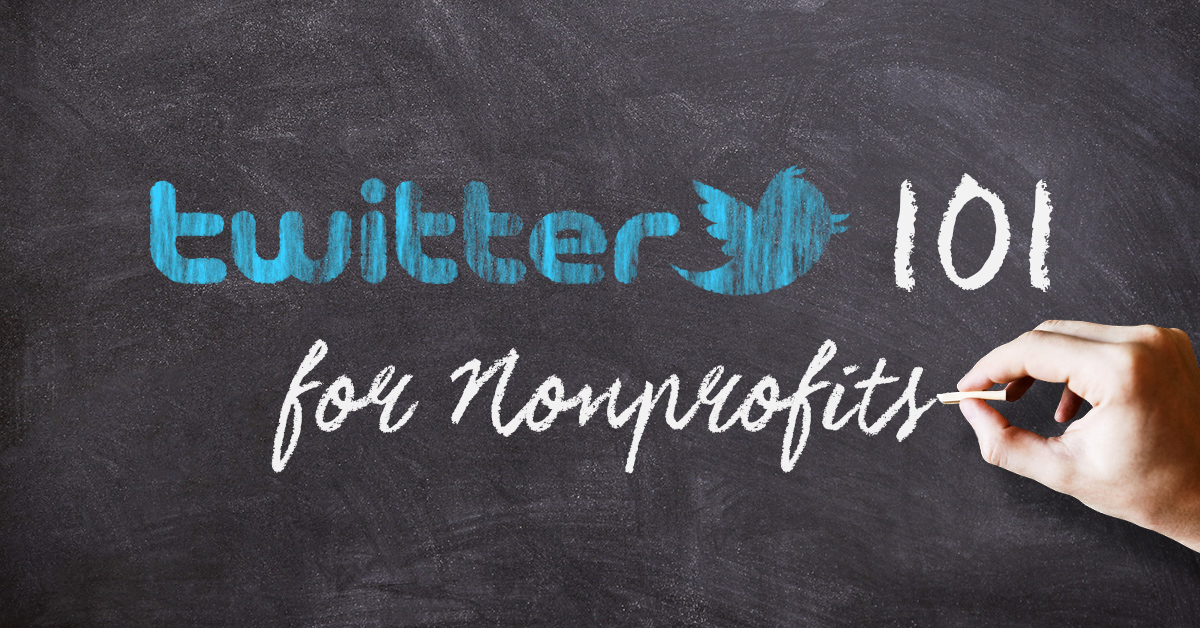Twitter is the perfect place for your nonprofit to promote your cause, elevate your brand, and extend your reach through online discussion participation.
Why should I be on Twitter?
Twitter has been around since 2006 and I’ve been an active user since 2007. Some trends and nuances have changed but Twitter continues to be a very strong media player. News trucks, live shows on TV, and sporting events all capitalize on the live, hashtag-driven conversations in order to engage their audience.
Secondly, and more importantly, Twitter is a good tool for listening. Market research is right at your fingertips. People talk about themselves all day long. You know what TV shows your audience watches, what political candidate they love, and what causes are important to their hearts.
How do I get started on Twitter?
You can read about the basics of Twitter from Twitter themselves here. Go to www.twitter.com/signup to create your account. You’ll need to choose a username and password. Your username can be associated with only one email account. So, if this is troublesome, create a new email address. You’ll also need to set up your profile’s bio. Part of your bio also includes your website address.
This is what you’ll need:
- A header Image (1500 x 500 pixels)
- Profile Photo (400 x 400)
- Bio (160 Characters)
- Location (City, State)
- Website Link
- Theme Color (Hex Code)
Your social media images should have a consistent look and feel to reinforce your nonprofit’s branding. That said, each platform has their own size requirements.
Canva.com is a great tool for creating these images to specifications especially because they all want some version of a cover or header image (this is like a hero image on your website) and a square profile photo. If you have resources to create a square version of your logo for your Twitter Profile Photo, that is even better. These profile images (sometimes referred to as avis or avatars) should be easily recognizable on both desktop (1 square inch) and mobile (1 square cm).
When crafting your bio, make sure that it clearly communicates what you do and who you are. You have 160 characters to grab someone’s attention. Think of it as a call to action of sorts — the action being followed by the user.
After filling in your organization’s location and website link, choose your theme color. The theme color will make all linked content that color. This includes Twitter handles, image links, and site links. Ideally, this should be your brand’s primary color. Though, if it’s too light and hard on the eyes, you may want to choose a secondary color from your brand standards.
Who should I follow?
When you begin, choose three primary demographics to focus on. This makes it easier for you to utilize lists (more of Twitter 201) and focus your attention on key groups online.
A first suggestion might be your team members and supporters. Think about who else would be a good fit for your nonprofit. An animal rescue may want to follow veterinarians and pet suppliers. An organization who serves the local homeless population, may want to follow people in their city or county. All of those people are good potential donors and supporters.
What should I post?
Twitter is especially good for driving traffic to your web property. Of all of the social networks, Twitter’s culture tolerates both volume and repetition. Don’t be too shy about sharing your blog posts about the good you’re doing; over and over again.
A good rule is to share 80% other people’s news and 20% of yours but feel free to fiddle with the ratio. Just remember that the purpose of social media is to be social — engage in conversations, share other people’s content, and show your human side. This creates connection. An engaged and connected audience is more likely to become and remain a donor.
When should I post?
Tweet during live events, tweet when you’re inspired, tweet at optimal times for you. This may take a few weeks or months to establish what resonates with your audience and when. We recommend posting at least three times a day to maintain a healthy account.
To get you started, think about the times you take a break to look at your own social profiles (during breakfast – 7 a.m., during lunch – noon, and before leaving work – 4 p.m.). If your organization spans time zones, mix up optimal tweets for each zone. Have fun. Test and look at the analytics.
What about scheduling?
We recommend a hybrid approach to Twitter with some scheduled posts that drive traffic and organic activity. You can write your tweets ahead and use tools like Buffer, Hootsuite, TweetDeck, or SproutSocial to schedule.
You can install WordPress plugins on your web property like CoSchedule or Revive Old Post that will automate and cycle your site’s content to Twitter. This can be done after you’ve built out dozens of posts so you have a sufficiently large library to sustain the volume.
What about hashtags?
The primary function of hashtags is discovery (for your audience to find you) and filtering (so you can see specific tweets). A hashtag is created when the pound sign # is placed before a string of characters. Think of these hashtags as keywords. What would people click on and then find you? If you’re an animal rescue try #rescue or use a popular one like #AdoptDontShop.
#stray #dogs in urgent need of good loving homeshttps://t.co/DHEgcUcHYp#adoptdontshop #adoptdontbuy#rr pic.twitter.com/YFkkkZFmRZ
— The League Of Animal Rescue (@leagueofrescue) August 29, 2016
A hashtag can’t only be a number or include any punctuation. Best practices require you to capitalize each word. This makes it much easier to read, especially on mobile. You can’t own a hashtag but you can dominate the stream by volume of tweets.
Twitter chats (hosting one is more like Twitter 301) are a great way to utilize hashtags for a topic-centered conversation. See if there are any chats that apply to your nonprofit. Attendees of Twitter chats are more engaged as a whole.
Should I tweet at conferences?
Yes. Conferences these days almost always have an associated hashtag. Many times these hashtags are comprised of the acronym of the event and may include the last two digits of the year.
Take photos, tweet quotes, and use those conference and event-related hashtags to gain visibility for your cause.
"SMS is an effective way to communicate with millennials" – All the yes – from a millennial. #NTC16 pic.twitter.com/lXCrbRd3k2
— Brian Mattos (@BrianKMattos) March 22, 2016
Spend some time reading tweets during the conference, reply to people, retweet and follow. This is a good way to gain engaged, like-minded followers.
Can I advertise on Twitter?
Yes, of course Twitter encourages you to advertise!
Twitter provides great resources for getting ads started and you can find that here.
Our suggestion to to use your twitter ad dollars around conferences and those conference hashtags. Though Twitter is a great engager and driver of traffic, it is much less “direct response” than a Google Ad or a Direct Mail piece asking for a donation. Use Twitter to heighten your awareness into hyper targeted audiences.
For instance if there is an event and you’d like to target attendees to donate, simply target those attendees by using the hashtag and @ signs within your ad dashboard.
You can get hyper-targeted on Twitter – and we mean very specifically.
What about Analytics?
Twitter has great analytics out of the box. Go to analytics.twitter.com while signed in to your account. It will show your top tweet, mention, follower, media tweet, and card tweet. Card tweets are especially relevant to web-driven traffic (this can be enabled easily with Yoast SEO plugin).
Twitter’s analytics also gives you insights into your audience demographics including household income, age range, and interests. This data can help drive the copy and types of tweets in order to engage with your audience more closely.
Of course, Google Analytics will show how much traffic has been referred from Twitter, but these analytics give you a deeper dive into what is resonating with your audience. Though you can advertise, you don’t need to in order to access this data.
Twitter is a Long Game
We make no promises of 40% revenue growth in your donor base here. However, Twitter can have quick results with your intentionally created fundraising campaigns.
Just remember that Twitter has three primary functions: top of mind, visibility, and connection. Have fun, take photos at events, and you’ll be surprised at the results.


